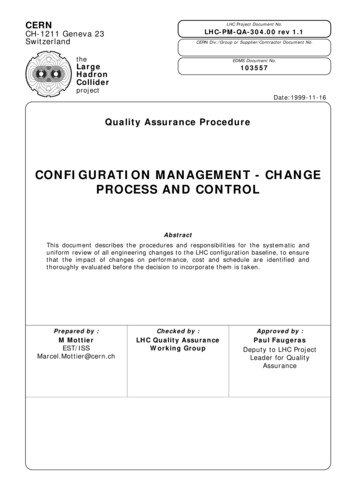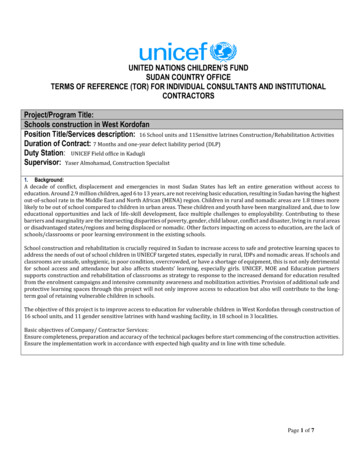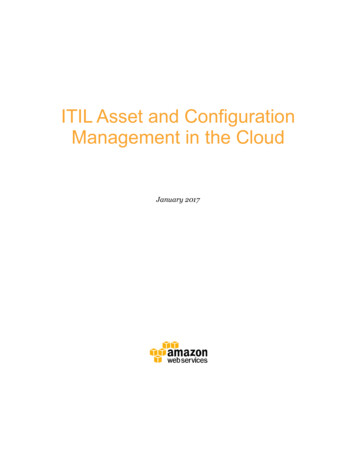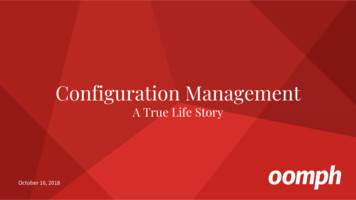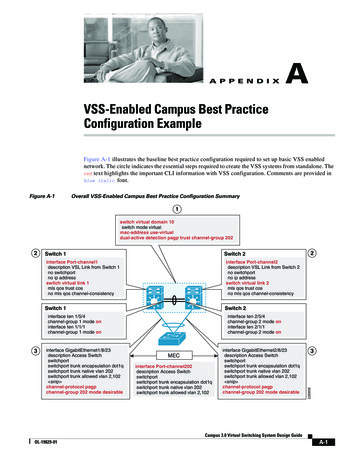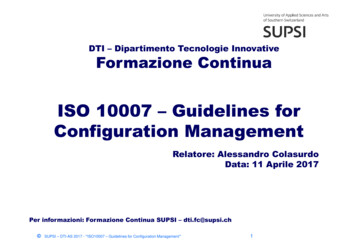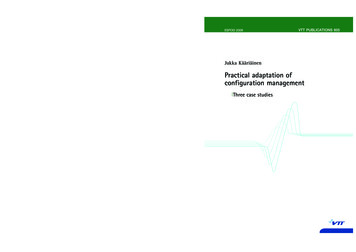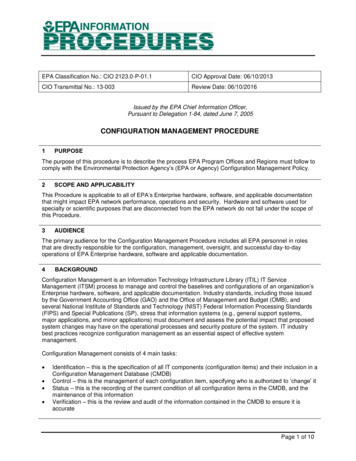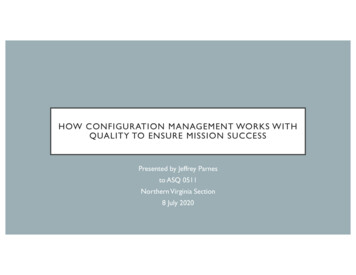
Transcription
HOW CONFIGURATION MANAGEMENT WORKS WITHQUALITY TO ENSURE MISSION SUCCESSPresented by Jeffrey Parnesto ASQ 0511Northern Virginia Section8 July 2020
WHAT IS CONFIGURATIONMANAGEMENT (CM)? CM is the practice of handling changes systematically so that a system maintains its integrityover time. CM implements the policies, procedures, techniques, and tools that manage, evaluate proposedchanges, track the status of changes, and maintain an inventory of system and supportdocuments as the system changes. CM programs and plans provide technical and administrative direction to the development andimplementation of the procedures, functions, services, tools, processes, and resources requiredto successfully develop and support a complex system. During system development, CM allows program management to track requirementsthroughout the life-cycle through acceptance and operations and maintenance. As changesinevitably occur in the requirements and design, they must be approved and documented,creating an accurate record of the system status. Ideally the CM process is applied throughoutthe system lifecycle2
CONFIGURATION MANAGEMENTHISTORY Configuration Management originated in the US DoD in the 1950s as a technical managementdiscipline for hardware material items—and it is now a standard practice in virtually every industry. The CM process became its own technical discipline sometime in the late 1960s when the DoDdeveloped a series of military standards called the "480 series" (i.e., MIL-STD-480, MIL-STD-481 andMIL-STD-483) that were subsequently issued in the 1970s. In 1991, the "480 series" was consolidatedinto a single standard known as the MIL–STD–973 that was then replaced by MIL–HDBK–61pursuant to a general DoD goal that reduced the number of military standards in favor of industrytechnical standards supported by standards developing organizations. This marked the beginning of what has now evolved into the most widely distributed and acceptedstandard on CM, ANSI–EIA–649–1998. Now widely adopted by numerous organizations and agencies,the CM discipline's concepts include systems engineering (SE), Integrated Logistics Support (ILS),Capability Maturity Model Integration (CMMI), ISO 9000, Prince2 project management method,COBIT, Information Technology Infrastructure Library (ITIL), product lifecycle management, andApplication Lifecycle Management. Many of these functions and models have redefined CM from its traditional holistic approach totechnical management. Some treat CM as being similar to a librarian activity, and break out changecontrol or change management as a separate or stand alone discipline.3
ELEMENTS OF CONFIGURATIONMANAGEMENT Configuration Management Planning and Management A configuration managementplan (CMP) describes any project specific procedures and the extent of theirapplication Configuration Identification (CI): Involves breaking down the project and creating areferencing system for each item. Configuration Control: Ensures that all changes to configuration items arecontrolled. Configuration control of specifications and test plans is vital for qualitycontrol to be effective. Configuration Status Accounting (CSA): Provides records and reports that relate toa deliverable and its configuration information. Configuration Verification Audit (CA): Determines whether a deliverable conformsto its requirements and configuration information4
5
CM PLANNING AND MANAGEMENT CM Planning and Management is a formal document and plan to guide the CMprogram that includes items such as: Personnel Responsibilities and resources Training requirements Administrative meeting guidelines, including a definition of procedures and tools Baselining processes Configuration control and configuration-status accounting Naming conventions Audits and reviews Subcontractor/vendor CM requirements6
7
CONFIGURATION IDENTIFIC ATION (CI): Configuration Identification (CI): Consists of setting and maintaining baselines, which define the system or subsystemarchitecture, components, and any developments at any point in time. The basis by which changes to any part of a system are identified, documented, andlater tracked through design, development, testing, and final delivery. Incrementally establishes and maintains the definitive current basis for ConfigurationStatus Accounting (CSA) of a system and its configuration items (CIs) throughouttheir lifecycle (development, production, deployment, and operational support) untildisposal.8
CONFIGURATION CONTROL Configuration Control includes the evaluation of all change-requests andchange-proposals, and their subsequent approval or disapproval. It covers the process of controlling modifications to the system's design,hardware, firmware, software, and documentation.9
CONFIGURATION STATUSACCOUNTING Configuration Status Accounting includes the process of recording and reportingconfiguration item descriptions (e.g., hardware, software, firmware, etc.) and alldepartures from the baseline during design and production. Deviations: A deviation from the contractual performance requirements or approveddrawings, a specific written authorization to depart from a particular requirement of anitem's approved configuration documentation for a specific number of units or period oftime. (Defined as "planned departure”) Waivers: a request for authorization to accept an item which, during manufacture or afterinspection, is found to depart from specified requirements, but nevertheless is consideredsuitable for use as is or after repair by an approved method. (Defined as"unplanned departure”) In the event of suspected problems, the verification of baseline configuration andapproved modifications can be quickly determined.10
CONFIGURATION VERIFIC ATION ANDAUDIT Configuration Verification and Audit: an independent review of hardware andsoftware for the purpose of assessing compliance with establishedperformance requirements, commercial and appropriate military standards, andfunctional, allocated, and product baselines. Configuration audits verify that the system and subsystem configurationdocumentation complies with the functional and physical performancecharacteristics before acceptance into an architectural baseline.11
CONFIGURATION BASELINES (FORMAL) Formal Baselines: Functional: The approved configuration documentation describing a system's or top levelconfiguration item's performance (functional, inter-operability, and interface characteristics)and the verification required to demonstrate the achievement of those specifiedcharacteristics Allocated: The current approved performance oriented documentation, for a CI to bedeveloped, which describes the functional and interface characteristics that are allocatedfrom those of the higher level CI and the verification required to demonstrate achievementof those specified characteristics Product: The approved technical documentation which describes the configuration of a CIduring the production, fielding/deployment and operational support phases of its life cycle.12
PRODUCT BASELINE The product baseline prescribes: All necessary physical or form, fit, and function characteristics of a CI, The selected functional characteristics designated for production acceptance testing,and The production acceptance test requirements13
CONFIGURATION BASELINES(INFORMAL) Informal Baselines Test: Version and documentation used for testing – changes as testing proceeds Release: Multiple baselines as features are incorporated Documentation: Baseline used for creating documentation14
CONFIGURATION AUDITS Functional Configuration Audit (FCA) The FCA is a configuration management examination of the product to verify, viatesting, inspection, demonstration, or analysis results, that the product has met therequirements specified in the functional baseline documentation. The examinationverifies that all authorized change proposals were incorporated into the productand documentation set prior to acceptance testing. Physical Configuration Audit (PCA) The PCA is a configuration management examination of the as-built (implemented)product configuration against its technical documentation. The PCA includes adetailed examination of the engineering drawings, design documentation, andspecifications to ensure that the documentation set is ready to support the postdevelopment processes.15
The Deepwater Horizon Disaster was made worse because the actual configuration ofthe well on the sea floor had not undergone a Physical Configuration Audit – theydidn’t know what its configuration was, making their recovery planning that muchmore difficult16
Most computer software products are updated regularly, with features or bug fixesadded with each release17
The first step in trouble shooting a problem is determining what it is you currentlyhave.18
If you look at the definition of CM and compare SCM, you’ll notice slight variations,most of which are the insertion of the word “software”.19
CONFIGURATION MANAGEMENTDATABASE The Information Technology Infrastructure Library (ITIL) specifies the use of aConfiguration management system (CMS) or Configuration management database(CMDB) as a means of achieving industry best practices for ConfigurationManagement. CMDBs are used to track Configuration Items (CIs) and thedependencies between them, where CIs represent the things in an enterprise thatare worth tracking and managing, such as but not limited to computers, software,software licenses, racks, network devices, storage, and even the components withinsuch items. The benefits of a CMS/CMDB includes being able to perform functions like rootcause analysis, impact analysis, change management, and current state assessmentfor future state strategy development. Many vendors commonly identifiy themselvesas IT Service Management (ITSM) systems20
INFORMATION ASSURANCE For information assurance, CM can be defined as the management of securityfeatures and assurances through control of changes made to hardware, software,firmware, documentation, test, test fixtures, and test documentation throughout thelife cycle of an information system. CM for information assurance, sometimes referred to as Secure ConfigurationManagement, relies upon performance, functional, and physical attributes of ITplatforms and products and their environments to determine the appropriatesecurity features and assurances that are used to measure a system configurationstate. For example, configuration requirements may be different for a network firewall thatfunctions as part of an organization's Internet boundary versus one that functions as aninternal local network firewall.21
MAINTENANCE SYSTEMS Configuration management is used to maintain an understanding of the status ofcomplex assets with a view to maintaining the highest level of serviceability for thelowest cost. Specifically, it aims to ensure that operations are not disrupted due tothe asset (or parts of the asset) overrunning limits of planned lifespan or belowquality levels. In the military, this type of activity is often classed as "mission readiness", and seeksto define which assets are available and for which type of mission; a classic exampleis whether aircraft on board an aircraft carrier are equipped with bombs forground support or missiles for defense Remember last year’s movie “Midway” – the Japanese had to reconfigure their aircraft whenthey changed their mission from attacking Midway Island to attacking the US carriers,allowing the US planes to catch them still on their carriers22
PREVENTIVE MAINTENANCE Understanding the "as is" state of an asset and its major components is anessential element in preventive maintenance as used in maintenance, repair, andoverhaul and enterprise asset management systems. Complex assets such as aircraft, ships, industrial machinery etc. depend onmany different components being serviceable. This serviceability is oftendefined in terms of the amount of usage the component has had since it wasnew, since fitted, since repaired, the amount of use it has had over its life andseveral other limiting factors. Understanding how near the end of their life each of these components is hasbeen a major undertaking involving labor-intensive record keeping until recentdevelopments in software.23
CONFIGURATION MANAGEMENT (CM)(CMMI-DEV) Summary The purpose of Configuration Management (CM) (CMMI-DEV) is to establish and maintain theintegrity of work products using configuration identification, configuration control, configurationstatus accounting, and configuration audits. Introductory Notes The Configuration Management process area involves the following activities: Identifying theconfiguration of selected work products that compose baselines at given points in time Controlling changes to configuration items Building or providing specifications to build work products from the configuration managementsystem Maintaining the integrity of baselines Providing accurate status and current configuration data to developers, end users, and customers24
25
CONFIGURATION MANAGEMENT ISQUALITY MANAGEMENT The lack of a robust configuration management implementation is a quality management issue.An example is a company that sabotaged itself by creating information silos which did notoperate under a common Configuration Management Plan as an integral part of the overallQuality Management Strategy. The Centers of Excellence agreed they can’t truly run like separate companies. Informationexchange through Configuration Management was just too critical to be ignored or lost in silos.The CEO mandated: Integrating Configuration Management at the enterprise level and flowing throughout the organizationalfunctions. Integrating test with design and systems engineering at the product level. Product level change control boards with representatives from all the centers. Vetting of changes across all stakeholders with wider distribution of released engineering. Capture of As-Built, As-Tested, As-Delivered and As-Maintained configurations by serial number. The entire organization to understand that configuration management, just like quality control, is not afunction to be relegated only to the CM group or the QA department but belongs to everyone.26
QUALITY ASSURANCE ANDCONFIGURATION MANAGEMENT Sandia National Laboratories implemented quality assurance and configuration systems essentialto the control and traceability of modeling used to demonstrate regulatory compliance The need to efficiently manage and tightly control the information used to demonstrate regulatorycompliance and the scientific basis underlying program positions was recognized and addressed by Sandia asa major component in the success of the WIPP Compliance Certification Application process. This requirement involved interactions between those responsible for collecting and interpreting sitecharacterization data and those using the data to perform predictive analyses. A formal program to control and document these interactions and manage the subset of data andparameters selected for use in licensing was developed and implemented by Sandia. It proved essential in maintaining traceability, consistency, and reproducibility of modeling results andconclusions. In addition to the formal control of parameters selected for licensing analyses, this system alsomaintained full traceability to supporting documentation. This traceability allowed the ready retrieval of associated records, provided a transparent means to evaluatethe process by which conclusions were developed, and allowed regulatory judgments to be made about theadequacy of program positions.27
STANDARDS SUPPORTING OR INCLUDINGCONFIGURATION MANAGEMENT ANSI/EIA-649-1998 National Consensus Standard for ConfigurationManagement MIL-STD-973 Configuration Management (cancelled on 20September 2000) EIA-649-A 2004 National Consensus Standard for ConfigurationManagement NATO STANAG 4427 Configuration Management in Systems LifeCycle Management including ANSI EIA-649-C 2019 Configuration Management Standard NATO ACMP 2000 Policy on Configuration Management ISO 10007:2003 Quality management systems – Guidelines forconfiguration management NATO ACMP 2009 Guidance on Configuration Management Federal Standard 1037C NATO ACMP 2100 Configuration Management ContractualRequirements GEIA Standard 836–2002 Configuration Management Data Exchangeand Interoperability CMMI CMMI for Development, Version 1.2 ConfigurationManagement IEEE 829 Standard for Software Test Documentation CMII-100E CMII Standard for Enterprise Configuration Management 828-2012 IEEE Standard for Configuration Management in Systems andSoftware Engineering. 2012. doi:10.1109/IEEESTD.2012.6170935.ISBN 978-0-7381-7232-3. Extended List of Configuration Management & Related Standards ITIL Service Asset and Configuration Management ISO 20000:1 2011& 2018 Service Management System.28
GUIDELINES IEEE 828-2012 Standard for ConfigurationManagement in Systems and Software Engineering,published date:2012-03-16 ISO 10007:2017 Quality management – Guidelinesfor configuration management NATO ACMP-2009 – Guidance on configurationmanagement EIA-836 Consensus Standard for ConfigurationManagement Data Exchange and Interoperability MIL-HDBK-61B Configuration ManagementGuidance, 7 April 2020 MIL-STD-3046 Configuration Management, 6 March2013 and canceled on June 1st, 2015 ANSI/EIA-632-1998 Processes for Engineering aSystem Defense Acquisition Guidebook, elements of CM at4.3.7 SE Processes, attributes of CM at 5.1.7 Lifecyclesupport ANSI/EIA-649-1998 National Consensus Standard forConfiguration Management Systems Engineering Fundamentals, Chapter 10Configuration Management GEIA-HB-649 – Implementation Guide forConfiguration Management Configuration Management Plan United States Dept.of Defense Acquisition document29
REFERENCES Audit Configuration: nce/audit-configuration MIL-HDBK-61A: Configuration Identification: bk-61a-5-5.htm Request for Waiver: https://en.wikipedia.org/wiki/Request for waiver Deepwater Horizon: 5spill.html Configuration Management: https://en.wikipedia.org/wiki/Configuration management Configuration Management (CM) -management-cm-cmmi-dev Quality Assurance and Configuration lery/uploads/QA CM.pdf30
QUESTIONS/CONTACTS Jeffrey M. Parnes Configuration Management Working Group Webmaster and Board Member 703.424.2956 (P) 484.307.2552 (F) webmaster@cmwg.org or jeff@parnes.net http://www.cmwg.org or http://pacm.parnes.net @CMWorkingGrp or @jeffparnes31
CONFIGURATION MANAGEMENT (CM) (CMMI-DEV) Summary The purpose of Configuration Management (CM) (CMMI-DEV) is to establish and maintain the integrity of work products using configuration identification, configuration control, configuration status accounting, and configuration audits.
